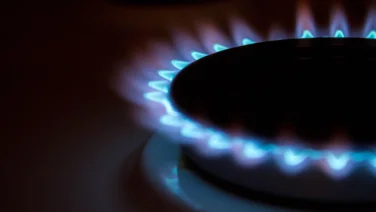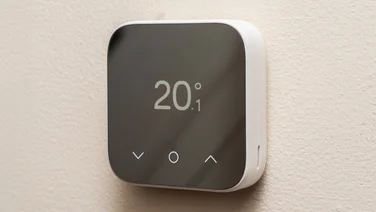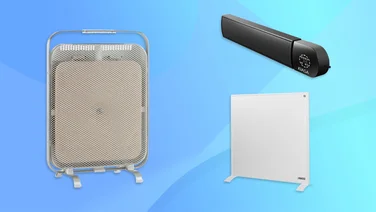To help us provide you with free impartial advice, we may earn a commission if you buy through links on our site. Learn more

When you’re planning to go solar, the technical jargon can feel overwhelming. Monocrystalline, polycrystalline, thin film, thermal-photovoltaic… all these terms and more are used (often at the same time) to describe solar panels, but what do they mean? And does it really matter which type of solar panel you choose?
The truth is, it does matter – but only up to a point. The amount of energy a solar PV system can produce is mainly down to its size and the quality of its installation. But some types of solar panels are more efficient, attractive, durable and expensive than others, so you’ll want to choose the right panel type for your needs, tastes and budget.
In this article, we’ll reveal the most popular types of solar panels in the UK, explore some innovative newcomers and help you choose the right panel type for your home.
Get a free quote from solar installers today
If you’re ready to chat to solar installers in your area, enter a few details in our short form below. Our trusted specialists will be in touch with tailored quotes.
What types of solar panels are there?
What are the main solar panel types in the UK?
Monocrystalline (mono) and polycrystalline (poly) panels are the two most popular types of solar panels for homes. They, like nearly all the panels we mention in this article, are PV (photovoltaic) panels that create an electric current using light. Mono and poly panels are both made from silicon, a common chemical element that works as a semiconductor and gives the panels their PV capabilities.Monocrystalline solar panels tend to be more efficient and more expensive, while polycrystalline panels tend to be cheaper and less efficient.
Another widely used type of solar panel in the UK is thin film. Thin film solar panels also use photovoltaic semiconductor technology, but less of it than crystalline panels. What the thin film panels lack in power they make up for in versatility.
Here’s more detail on the pros, cons and costs of each of these main panel types.
1. Monocrystalline solar panels
Monocrystalline solar panels are each made from a single piece of silicon, which is easy for electricity to flow through. This is why mono panels are the most efficient panel you can commonly buy, with efficiency ratings often higher than 22%. The single-silicon manufacturing process also gives the panels a sleek, modern look and relatively dark finish.
The average lifespan of a mono solar panel is up to 40 years, so a system of them will cover your electricity needs long after it pays for itself through reduced bills.
The average price of a single 350W monocrystalline panel depends on which renewables guru you ask. Heatable reckons a mono 350W panel costs around £300, while The Eco Experts say it’s more like £790. Some of the most efficient and highly rated mono panels cost much less than that. You can get the new, and hugely powerful, Aiko Monocrystalline 615W N-Type solar panel for £188 from Plug-in Solar.

2. Polycrystalline solar panels
Polycrystalline solar panels, as the name suggests, are made from multiple pieces of silicon that are melted together, then cut into cubes. The result looks more blue than monocrystalline, and creates a mosaic look. Less silicon is wasted in the process, but electricity finds it harder to flow through the mix, so efficiency ratings are lower than monocrystalline panels.
You can buy a 285W poly panel for little over £100 from Plug-in Solar, so the upfront costs are less. But their lower power and efficiency ratings mean you get less energy for your buck.

3. Thin film solar panels
Thin film panels are made from multiple layers of photovoltaic material of various kinds. Their efficiency ratings are too low for house roofs, but they have loads of other uses. For example, you can lay or wrap a thin film solar panel over your boat, campervan or shed to keep your battery or tools charged.
Costs vary widely for thin film solar products. You can buy an adhesive 150W thin film panel from Renology for £330, but a tiny waterproof 2W solar panel from Amazon is powerful enough to keep your garden lights on, and costs just £6.

Which type of solar panel is the most popular?
Thin film solar panels are the world’s most popular type of solar panel. They’re used in countless applications from powering pocket calculators to sending NASA’s Psyche spacecraft on a 2.4 billion-kilometre mission. No wonder the global thin film solar market is forecast to rise from $13bn in 2023 to a whopping $27bn by 2032.
Monocrystalline panels, which account for most of the best residential solar panels you can buy in the UK today, are also very popular. The world’s mono solar panel market is set to grow from $5.6bn in 2022 to $12.6bn by 2032, an annual growth rate of more than 8%, similar to thin film. The polycrystalline market is estimated to go from $3.1bn in 2022 to $6.18bn by 2032, up just over 7% annually.
The UK’s solar governing body, the Microgeneration Certification Scheme (MCS), doesn’t publish data about different panel types. But it did record 189,826 solar installations on UK homes in 2023 – an impressive 30% increase on 2022.
READ NEXT: How efficient are solar panels?
What other types of solar panels are available?
New solar panel options have arrived to shake up the market and give consumers more choice. Many of them are actually new monocrystalline designs or new ways of using thin film, but we’ll describe them all separately for the sake of clarity.
1. PERC (passivated emitter and rear contact) solar panels are a new, improved type of monocrystalline panel. They go through a different manufacturing process that increases the amount of electricity they can produce. PERC solar panels are only slightly more expensive to produce than conventional mono panels, but they’re even more efficient, so their long-term cost may work out lower.
2. Solar roof tiles use thin film solar panel technology to cover the surface of a roof tile with solar PV material. They look fabulous, even offering a solution to planning limitations on listed buildings, and are more durable than standard solar panels. In fact, they’re even more durable than standard roof tiles. But they lack efficiency and are very expensive.
3. Solar thermal panels aren’t solar PV panels. Instead of producing electricity, they use the sun’s rays to heat up your domestic hot water. Also known as solar water heaters, these panels are commonly sited next to an array of PV panels and have been calculated to cut a typical household’s heating bills by 50%.

PERC solar panels, solar roof tiles and solar thermal panels are all currently available for UK households. They’re growing in popularity as people aim to shrink their carbon footprint and save money on household bills.
These other types of solar panel are more typically used on commercial buildings:
4. Transparent solar panels, aka glass solar panels, use a see-through type of thin film solar technology. The film can be mounted on glass to effectively turn windows into solar energy generators.
Transparent solar panels have the potential to be integrated into all windows and even mobile phones, but at the moment they’re too low in efficiency and high in cost to be used anywhere other than large commercial buildings.
5. Bifacial solar panels are essentially the same as monocrystalline panels, but with two sides. In other words, they can generate electricity from the back as well as the front. These aren’t used in the residential market, but they’re gaining traction in commercial applications such as ground-mounted solar arrays.
Finally, here are a couple of new solar panel types that aren’t available in the UK yet:
6. CPV (concentrator photovoltaic) solar panels are like PV panels, only more so. CPV solar technology produces many times more electricity than PV from the same amount of sunlight, so these panels need much less roof space. According to experts, CPV systems may start appearing on UK roofs as soon as 2025.
7. Perovskite is a type of silicon that can absorb light across almost all visible wavelengths, so it can convert much more sunlight into electricity. Tests with perovskite solar panels in Oxford have achieved efficiency ratings of 27%. Perovskite panels aren’t available yet in the UK (reports say they’ll be “a few more years”), but they are set to be the future of solar panels.
READ NEXT: Solar roof tiles: Turn your roof solar
How do all these different solar panels types compare?
Here’s an at-a-glance comparison table of most of the solar panel types we’ve mentioned, covering factors such as efficiency and cost:
| Type of solar panel | Ave cost per m² | Efficiency (%) | Lifespan (years) | Available in UK? |
| Monocrystalline | £393 | 18-24 | 25-30 | Yes |
| Polycrystalline | £325 | 13-16 | 25-30 | Yes |
| Thin film | £99 | 7-13 | 10-20 | Yes |
| PERC | £360 | 17-20 | 25-35 | Yes |
| Solar roof tile | £294 | 10-20 | 25-30 | Yes |
| Solar thermal | £670 | 70* | 20-25 | Yes |
| Transparent | £250 | 1-10 | 25-30 | Yes |
| Perovskite | N/A | 28-33 | 25-30 | No |
Data from The Eco Experts
*Solar thermal panels convert sunlight into heat, not electricity
Which type of solar panel should I use?
With so many solar panel varieties to choose from, and more set to arrive on the market, which type should you go for? Assuming you want panels for the roof of your house, we recommend chatting to your installer about high-quality monocrystalline or PERC panels. These are the most efficient and cost-effective panels you can currently buy, and they will generate clean energy for your home for decades to come.
If you’re looking for panels for a DIY project or to power a structure such as a shed, houseboat or campervan, then portable polycrystalline or thin-film solar panels may be your best bet. These often come in DIY solar panel kits that also include energy storage batteries and all the system components you need. There’s an excellent range of DIY solar panel kits at UK site Sunstore Solar.
If you live in a listed building, conservation area or other place where planning limitations rule out solar panels, then solar roof tiles or even transparent solar panels, aka glass or window solar panels, will be a better bet – if you can afford them.
Whatever type of PV panel you go for, look into adding a solar thermal panel if you would like to cut your gas bill as well as your electricity one.
Ultimately, the type of solar panels you go for is less important than the quality of their installation and the overall size of the system. To find out how big your solar array should be, see our article “How many solar panels do you need?”. A professional installer will work with you to choose the best type and brand of solar panels to create your system.






